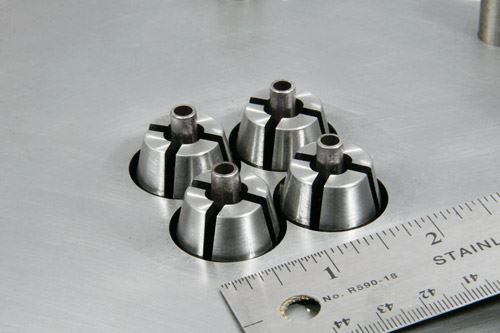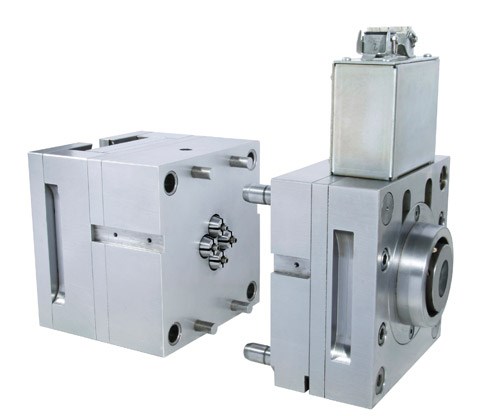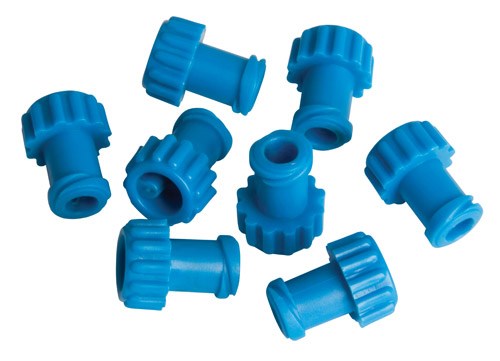Run Clean, Run Efficient
Better undercut release for small medical parts.
Medical parts have different requirements than other molded articles, and as a result tooling engineers over the years have pioneered new mold materials, coatings and mold maintenance practices.
For example, a typical luer fitting is used for making a secure, leak-proof attachment with tubing connections in medical devices and other instruments. These small connectors frequently have undercuts, and when they do, there are considerable cost and risk implications for the molding of these parts. However, practices are evolving and tooling engineers have begun using a single, expanding cavity component as an alternative to slide mold traditions of the past.
Containing the part’s undercuts within an expandable cavity results in a mold that is smaller and simpler, with less moving parts. Design time is reduced and mold construction hours are less. With a smaller mold, lower hourly press rates result, and when a mold is less complex, it is easier and less costly to properly maintain.
Slide molds require lubrication, introducing opportunities for part contamination, while an expandable cavity requires no such grease. And rather than nesting round parts within long slides, more conformal cooling and a more balanced runner system can be achieved by using a component that forms the part concentrically.
Expandable cavities are constructed in an expanded position, meaning that during molding they are pulled back against a striker ring and collapsed inward. For ejection, the component is staged forward, which allows the segments of the expandable cavity to expand outward. This releases the undercut and the part is then ready for ejection. They are commonly staged forward during mold open to enable the fastest possible cycle time.
Report from the Field: Expandable cavities can sometimes be a project-saving solution, as it was for Cape Fear Mold & Tool Co., Inc. Mike Rockwell explains that his customer required two hot runner molds with undercuts to be built. “One of the molds was fairly simple except for some undercuts, but the second mold turned into a bear,” he says. “It had a long, thin core running thru the center, undercuts on the inside that required the expandable cavities, undercuts around the outside that required slides, and, to top it all off, it had a 0.016” vent hole in the face.”
The complexity of the second mold wasn’t the only criterion that had to be met, but there were also space considerations and a tight delivery time to think about.
“The expandable cavity system was really the only option,” Mike notes. “We had worked with several collapsible cores in the past and have always been quite happy with those, so I was confident the expandable cavity system would work just as well. The beauty of the expandable cavities is that there is really no way to crash the mold.”
The project was a success, and Mike said his customer was very satisfied. “My customer couldn’t have been happier with the mold,” he says. “They were actually surprised when we completed the project without any design change requests.”
In medical molding, the stakes are high. The ramifications that are on every tooling engineer’s mind can cause one to default into building the next tool much like the last tool. However, beyond the cost savings of a smaller and more straightforward mold build, containing the part’s undercut details within a single component ensures part accuracy, optimal cooling, greaseless molding, and dramatically simplified mold maintenance. These advantages reduce risk and liability over the course of a medical mold’s lifetime.
Related Content
How to Eliminate Chatter
Here are techniques commonly used to combat chatter and guidelines to establish a foundation for optimizing the moldmaking process.
Read MoreMachining Center Spindles: What You Need to Know
Why and how to research spindle technology before purchasing a machining center.
Read More6 Ways to Optimize High-Feed Milling
High-feed milling can significantly outweigh potential reliability challenges. Consider these six strategies in order to make high-feed milling successful for your business.
Read MoreIt Starts With the Part: A Plastic Part Checklist Ensures Good Mold Design
All successful mold build projects start with examining the part to be molded to ensure it is moldable and will meet the customers' production objectives.
Read MoreRead Next
Reasons to Use Fiber Lasers for Mold Cleaning
Fiber lasers offer a simplicity, speed, control and portability, minimizing mold cleaning risks.
Read MoreHow to Use Strategic Planning Tools, Data to Manage the Human Side of Business
Q&A with Marion Wells, MMT EAB member and founder of Human Asset Management.
Read MoreAre You a Moldmaker Considering 3D Printing? Consider the 3D Printing Workshop at NPE2024
Presentations will cover 3D printing for mold tooling, material innovation, product development, bridge production and full-scale, high-volume additive manufacturing.
Read More




















